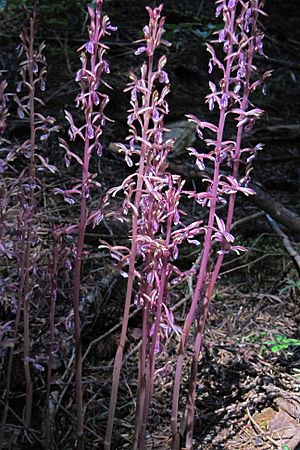Pacific coralroot facts for kids
Quick facts for kids Pacific coralroot |
|
|---|---|
 |
|
| Scientific classification | |
| Genus: |
Corallorhiza
|
| Species: |
mertensiana
|
| Synonyms | |
|
|
The Pacific coralroot (scientific name: Corallorhiza mertensiana) is a special type of orchid found in the cool, shady forests of northwestern North America. People also call it the Western coralroot or Mertens' coralroot. This plant was once thought to be a smaller version of another orchid, but scientists decided it was its own unique species in 1997.
Contents
Discovering the Pacific Coralroot
The Pacific coralroot is a unique plant because it doesn't have any leaves. It's a parasite that lives for many years. This orchid can grow to be about 6 to 20 inches tall.
What Does It Look Like?
The stem of the Pacific coralroot can be red or brownish-purple. Its flowers are very pretty. The top petals are usually pink to reddish-pink, with veins that are yellow to dark red. The lower petals are wider and are dark pink to red. They have three deep red veins. Below the lower petal, there's a noticeable spur. You can see these flower spikes from May to August.
Roots Like Coral
Instead of regular roots, the Pacific coralroot has hard, branched underground stems called rhizomes. These rhizomes look a lot like coral, which is how the plant got its name!
How Pacific Coralroot Gets Food
The Pacific coralroot is a very interesting plant because it doesn't make its own food using sunlight like most plants. This is because it doesn't have leaves. Instead, it gets its food from tiny living things in the soil.
Working with Fungi
This orchid is a "myco-heterotroph." This means it gets its nutrition from special fungi that live around tree roots. These fungi are called "ectomycorrhizal fungi." The fungi help trees by giving them minerals and carbon. In return, the trees give the fungi food. The Pacific coralroot then "borrows" carbon (food) from these fungi. It's like the orchid is sharing a meal that the fungi got from the trees!
Picky Eaters
Interestingly, the Pacific coralroot is very specific about which fungi it partners with. It only works with certain types of fungi from a family called Russulaceae. Even when the Pacific coralroot grows in the same spot as another type of coralroot orchid (like Corallorhiza maculata), they will never share the same kinds of fungi. Each orchid has its own special fungal friends!
Where Pacific Coralroot Lives
The Pacific coralroot likes to grow in shady conifer forests. These are forests filled with trees like pines and firs. It usually lives in places that are not too high up in the mountains.
Favorite Places to Grow
This orchid prefers damp soil that has a lot of rich, decayed plant material, called humus. It also likes spots where it gets some sunlight filtering through the trees.
Where You Can Find It
You can find the Pacific coralroot in the Cascade Range mountains, all the way from Alaska down to California. It also grows in the Rocky Mountains, from Alberta in Canada down to Wyoming in the United States.
In 1923, scientists exploring Glacier Bay, Alaska, found this orchid growing under thick bushes of Alnus tenuifolia. In British Columbia, Canada, it has been found growing near plants like Gaultheria shallon and mosses such as Hylocomium splendens.
Gallery
See also
 In Spanish: Corallorhiza mertensiana para niños
In Spanish: Corallorhiza mertensiana para niños


